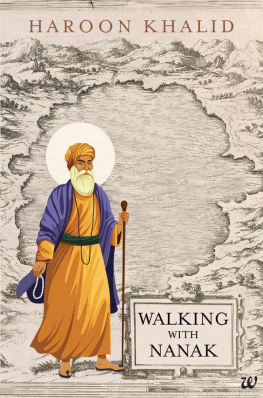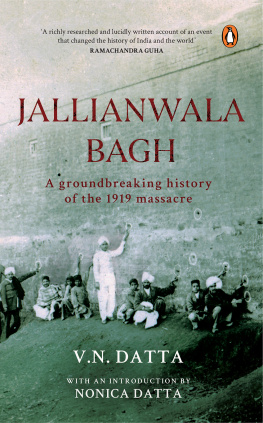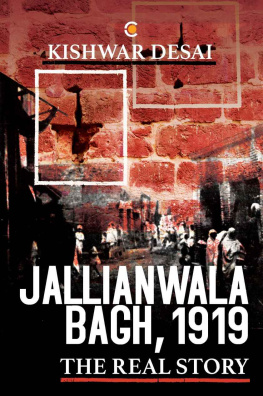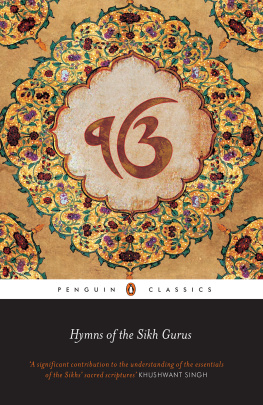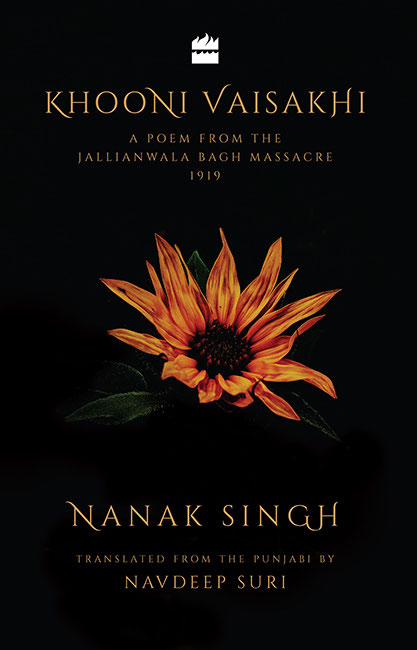KHOONI VAISAKHI
A POEM FROM THE
JALLIANWALA BAGH MASSACRE
1919
...........................
NANAK SINGH
translated from the punjabi by
NAVDEEP SURI
CONTENTS
I had thought of translating my grandfather Nanak Singhs long poem Khooni Vaisakhi a few years back. I had completed translating his novel Adh Khidya Phul (A Life Incomplete) around the time, and was awaiting its publication. I took a cursory look at the poem, played around with a few verses in my head and gave up. Translating verse from Punjabi into English just wasnt my cup of tea, I decided. I should stick to prose.
But I was piqued by the fact that Khooni Vaisakhi wasnt just another one of his many books. It stemmed from a deep personal experience and was spot on with its historical references. Looking at some of his novels that were similarly rooted in real events, I zeroed in on Ik Myan Do Talwaran. This was the book that won him the Sahitya Akademi Award in 1962 and it was a story based around the martyrdom of Kartar Singh Sarabha and the famous Ghadar movement which saw an improbable group of young Indian nationalists in Vancouver and San Francisco coordinate with like-minded patriots from India in an abortive attempt to overthrow the British Raj in India. I was struck by the amount of research that the author had done to put together a truly memorable narrative. I started work on its translation and had made fair headway when the unfinished work met with an unusual accident. I had been posted as ambassador to Egypt and was diligently preparing for the move from Delhi. Among the hundreds of chores involved in the move was the relatively mundane task of copying all my personal files from the office laptop on to different pen drives before cleaning up the laptop, emptying its trash bin and returning it to office. One of these files was the incomplete translation of Ik Myan which I had planned to continue after settling down in Cairo. To my horror, the file that I copied was an old version that basically had the books foreword and little else. I contacted my cousin Simar, an IT pro, to see if he could retrieve the deleted files from the laptop. His verdict: I had been a bit too diligent in cleaning up the computer. The files were beyond retrieval and there was nothing to do but to rue my own ineptitude.
And to take a break from translation. The last few years were also a blur in terms of the pressure of work and the disruptive effect of consecutive moves from Cairo to Canberra to Abu Dhabi and it wasnt until the middle of 2018 that the thought of translating Khooni Vaisakhi came up again during a visit to Amritsar. This time, it was in the context of a conversation with my parents about the upcoming centenary of the Jallianwala Bagh massacre in 2019 and the importance of taking Khooni Vaisakhi to a wider audience. Despite my reservations about translating verse, I decided to take up the project in earnest. But first, I would have to teach myself a thing or two about translating poetry.
Some years ago, at the Jaipur Literature Festival, I had attended a session where authordiplomat Pavan Varma and renowned poet Gulzar produced a delightful jugalbandi. In his uniquely mellifluous baritone, Gulzar would read one of his less-known poems in Hindi and Pavan would read a fluent English translation of the same poem from his book Neglected Poems. Gulzar had also graciously joined me at the launch of A Life Incomplete at the same festival in January 2012 and his generous compliment to Pavan that in some of the poems, the translation read better than his original stuck in my head. I had bought a copy of Neglected Poems and I now dove into it with a sense of purpose, hoping perhaps to find the magic key that would help me unlock Khooni Vaisakhi. It is a beautiful book of translation, but I found nothing that I could connect with my project.
Part of the problem, I realized, was that Gulzar wrote in free verse. That gives a fair bit of latitude to the translator in the choice of vocabulary, in framing the lines. However, Khooni Vaisakhi has a consistent rhyme and metre and the lessons gleaned from the translations by Pavan didnt quite apply in my case. I discussed my dilemma with friends whose understanding of poetry is a lot better than mine. Several suggested that since Khooni Vaisakhi is a historical work, it is more important to accurately convey its content than to obsess over the rhythm and rhymes. They advocated that I should exercise my own poetic licence to translate it into free verse. I was grateful for their advice, but still felt that I didnt have the liberty to make such a radical departure from the original. Somewhere in the deeper recesses of the mind was Robert Frosts intemperate remark that poetry in free verse is a bit like playing tennis without a net. Implicit in his observation is the recognition that rhyme and rhythm impose constraints and the greater challenge lies in translating within the parameters set by the constraints.
It was around that time I remembered Michael Pelletier, an outstanding American diplomat who is fluent in several languages. Both of us spoke some Arabic and French and he had once given me a copy of Douglas Hofstadters masterly Le Ton beau de Marot In Praise of the Music of Language. I spent the next few days ploughing through the book, often pausing to marvel at the fecundity of Hofstaders intellect. He is quite an exceptional person a cognitive scientist, a Pulitzer Prize winning author, a musician and a polyglot with a particular fascination with the way we work with languages. In Le Ton beau, he takes A une damoyselle malade, a short poem by sixteenth-century French poet Clement Marot and plays around with over eighty different translated versions of the poem to drive home the flexibility that a translator can enjoy. But for the specific purpose of my inquiry, Hofstadter provided the answers in Chapter 8, which is largely devoted to Alexander Pushkins Eugene Onegin a novel written entirely in verse. He takes four separate translations of the book and places select excerpts in four windows, asking the reader to rank them in order of preference. In doing so, he provides a rare perspective on the craft of four accomplished writers who had independently worked on the same text, each imparting their own distinct signature to the translation. But for me, the decisive element was the fact that each of them stuck to Pushkins rhyme and metre even as they took some liberties with other aspects of the poem.
Hofstadter uses this example to make an important argument. Constraints like rhyme and metre are an integral part of the poets work and it would be a travesty to ignore these factors when translating verse. He argues that the linguistic pattern of writing is no less important than the content. The relationship between form and content is so close that to select one at the expense of the other would be inexcusable.
And with that, the decision was made. The translation must attempt to be faithful to the original not just in terms of the content but also in its rhyme and cadence.
That put my own ambivalence at rest and allowed me to complete a first draft of the translation before turning towards a couple of other aspects that were important for the project. As a poem, Khooni Vaisakhi is barely 900 lines (around 4000 words) long a pamphlet that served the purpose in 1920 when it could be priced at four annas (twenty-five paise) and might have been sold in large numbers had it not been confiscated. To become a contemporary book, it needed some heft, some context and a couple of additional perspectives.


